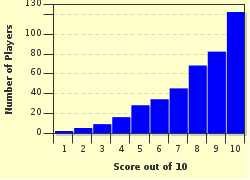Quiz Answer Key and Fun Facts
1. Some of the most famous of the Bible's tumbled down walls come in the book of Joshua. The Israelites, fresh from slavery and wanderings in the wilderness, were beginning their conquest of Canaan. Which city was taken by blowing rams' horns whilst marching round its walls for a week?
2. Once the Israelites had settled in Canaan, the book of Judges relates how they alternated between periods of faith and periods of less than faith. The former were inspired by God-given leaders called judges. One of these was a man renowned for his strength. His final act, blinded and chained, was to tear down pillars and bring the walls of a building tumbling down upon his Philistine captors. What was his name?
3. Perhaps the greatest period of Israel's history came under King David and his son, Solomon. Among Solomon's many achievements were the building of the first Jerusalem Temple and the writing of many proverbs. In the book of Proverbs is a verse, attributed to Solomon, that likens a city with tumbled down walls to a man, who lacks what?
4. In the sixth century BC, Israel was conquered by the Babylonians and its leading people taken into exile. Prior to this, many of the Old Testament prophets had been chiding the nation for the lack of faith that would lead to disaster. The prophet Isaiah used an image that would later recur in Jesus' parables. He had God describe Israel as something that would have its wall broken down and be trampled. To what was he referring?
5. Here is a rarity, a city that falls to its enemies without the walls coming tumbling down. It is also one of the most significant captures in Biblical history.
The Old Testament relates that the Jews were liberated from exile in Babylon under the Median king, Cyrus the Great. In 539 BC, Cyrus was faced with the challenge of how to capture Babylon. According to the Greek historian, Herodotus, Cyrus' army laid siege to the city. The walls and gates were well defended to the point of being impregnable. The townspeople had stockpiled several years' worth of food. The river Euphrates ran through a tunnel under the city walls so there was plenty of fresh water. Cyrus took the city without breaking down a gate or wall. How did he do it?
6. When the Babylonians captured Jerusalem they made a good job of bringing walls tumbling down. As Jews began to return to the city, they were faced with a massive rebuilding project. Which two books of the Bible tell this story?
7. Jesus told a parable about a wise man and a foolish man. Both built houses but on different foundations. When storms came, the walls of the foolish man's house came tumbling down. What foundation had he chosen?
8. A key piece of evidence at Jesus' trial was the assertion that he had claimed he would bring the walls of the Temple tumbling down, and rebuild it in how many days?
9. In the book of Acts, Paul and Silas were being held in a Philippi prison. A strong earthquake shook the building and this was sufficiently powerful to blow out the doors and break free the chains. It is quite possible that walls may have come tumbling down too. At the very least, a structural survey would have been advisable. What was the first response of the jailer when he saw what had happened?
10. The writer of the book of Ephesians speaks metaphorically about the tumbling down of walls. He writes that the death of Jesus tore down a barrier that divided which two parties?
Source: Author
glendathecat
This quiz was reviewed by FunTrivia editor
CellarDoor before going online.
Any errors found in FunTrivia content are routinely corrected through our feedback system.

